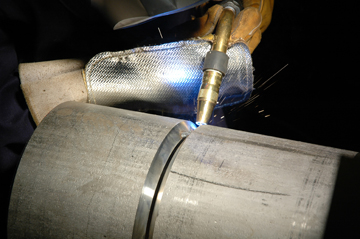Filler Metals for Welding Austenitic Stainless Steel Tube and Pipe
Like any application, welding austenitic stainless steel or 300 series tube and pipe presents specific challenges. It requires special attention to heat input and post-weld cooling in order to achieve optimal results, and it also requires the right filler metal. Matching the appropriate filler metal to this material can help ensure that the welds maintain their corrosion resistance, toughness and mechanical properties — all factors that are critical for austenitic stainless steel to enter successfully into service in pharmaceutical, energy, and food or chemical processing applications where this material is commonly found.

metal-cored wires can be used to weld from the root to
cap passes on thicker-walled pipe, even out of position.
The importance of filler metals
Hot cracking — a defect that occurs immediately upon completion of the weld —is the biggest potential threat when welding austenitic stainless steel, including the 304L and 316 grades commonly used in tube and pipe applications. This material has a particularly large grain structure, making it more susceptible to this defect than other types of materials.
The combination of the right filler metal, as well as proper control of heat input and post-weld cooling can help prevent hot cracking. These factors offer the added benefit of protecting the material’s corrosion resistance during the welding process.
Filler metals for welding austenitic stainless steel, as with any welding application, must match the base material according to its chemical and mechanical properties. The process of making this match, however, is slightly easier with austenitic stainless steel than many other materials. That’s because the intended service condition dictates what grade of austenitic stainless to use for the application. In turn, the grade of material dictates what filler metal should be used. Achieving the proper chemical and mechanical properties is, thereafter, a given.
To weld 304L austenitic stainless steel tube and pipe, the proper filler metal match is one with an American Welding Society (AWS) 308 or 308L designation. A 316L filler metal is the appropriate choice for welding 316 austenitic stainless steels. For welding a carbon steel valve or bracket to an austenitic stainless steel tube or pipe (a common industry practice), a 309 grade filler metal should be used.
These filler metals are designated for welding austenitic stainless steel due to the alloys that they contain, including chromium, molybdenum, nickel and silicon. Each element provides a distinct attribute in the completed weld.
• Chromium provides corrosion resistance.
• Molybdenum offers corrosion resistance, along with good high temperature performance.
• Nickel increases weld toughnesss
• Silicon helps maintain weld pool fluidity.
Engineers and designers often refer to a property in stainless steels known as the ferrite number. The ferrite number is a measurement of the amount of ferrite versus austenite in the structure of the material. The ferrite number is an indication of a stainless steel weld’s ability to resist cracking, and in some cases is an indication of its corrosion resistance. The amount of ferrite present is determined largely by the chemistry of the material. In general, the goal when welding austenitic stainless steel is to reach a maximum ferrite number between 3 and 7; however, special applications may call for higher ferrite numbers to achieve the best results.
Stainless steel filler metals: the options
Filler metals with 308(L), 316 and 309L designations are available in a variety of types, used according to the specific welding process. Most filler manufacturers offer:
• Shielded metal arc welding (SMAW) electrodes (commonly referred to as stick electrodes);
• Gas metal arc welding (GMAW) wires, including solid and metal-cored wires;
• Flux-cored arc welding (FCAW) wires; and
• Gas tungsten arc welding (GTAW) cut lengths
Each type of filler metal offers specific attributes and benefits, and has its best uses. Each has its own limitations, as well. Understanding these aspects is an important part of gaining good weld quality when welding austenitic stainless steel.
SMAW or stick electrodes
These electrodes are readily available in the marketplace — usually in diameters ranging from 3/32 to 5/32 inches — and familiar among welding operators, making them frequently chosen filler metals for welding austenitic stainless steel tube and pipe. They also aid in achieving proper ferrite numbers.
Stick electrodes work well when welding out-of-position or on applications that require access into complex joints where a welding gun cannot reach. They offer the advantage of being portable, as well, since they generate their own shielding gas during the welding process and do not require an external shielding gas cylinder. That is particularly helpful for field applications.
There are some limitations to welding with stick electrodes for austenitic stainless steel applications, namely that they are less efficient to use than other filler metals. Stick electrodes are only 12 inches long, so they require frequent changeover when welding. Also, welding operators typically only weld to within three inches of the end before changing to a new one. The downtime for changeover and the stub loss can cost time and money. These filler metals also generate slag, which requires downtime for cleanup, and the weld pool can be quite fluid, depending on the particular product, making it difficult for some welding operators to use.
Solid wires
Solid wires are a very common filler metal choice for welding thicker-walled austenitic stainless steel pipe — for example, over 1/2 inch wall thickness. They work well for welding fill and cap passes in the flat or horizontal position while the pipe is being rotated (e.g., after completing a GTAW root pass), and they can be used to weld out of position for root, fill and cap passes using a pulsed or advanced short-circuit process. These wires are typically available in diameters ranging from 0.030 to 1/16 inches, and they provide good deposition rates when welding on austenitic stainless steel pipe.
Solid wires for austenitic stainless steel can be more difficult to alloy than other types of filler metals, which can affect the availability of these filler metals and the size of the lots that filler metal manufacturers make. The raw materials needed to manufacture stainless steel filler metals are available in large heats and by a single chemistry. If an application requires very specific levels of an element in the wire (chromium, for example), it may be necessary to purchase very large batches of the solid wire and it may take more time for a filler metal manufacturer to develop the product.
Metal-cored wires
Metal-cored wires are becoming an increasingly popular alternative for welding thicker-walled austenitic stainless steel pipe. Like solid wire, these wires require pulsing or advanced short-circuit processes to weld out of position, but with these processes it is possible to weld from the root to the cap with the single filler metal; a GTAW root is not necessary.
Metal-cored wires offer several advantages for welding austenitic stainless steel tube and pipe.
• They provide faster travel speeds and greater deposition rates than solid wires, allowing welding operators to place more filler metal in the weld joint faster.
• They are also very good at bridging gaps, which helps with successfully welding tube or pipe joints that have misalignment or poor fit-up. They produce minimal spatter, minimizing post-weld cleaning.
• They are more easily alloyed than solid wires and can be made in smaller batches, decreasing the waiting period for specialty orders and reducing the amount companies need to purchase.
One disadvantage to stainless steel metal-cored wires is their cost. They tend to be more expensive than solid wires, but many companies find that the productivity and quality improvements outweigh the wire’s per-unit cost. These filler metals are available in 0.045- to 1/16-inch diameters.
Flux-cored wires
Flux-cored wires are good for achieving high deposition rates and good productivity when welding out of position on thick-walled austenitic stainless steel pipe. Unlike solid or metal-cored wires, this filler metal does not require a special power source to weld out of position; the flux coating on the wire acts like a dam that helps hold the molten weld pool in place.
Flux-cored wires do produce higher levels of smoke than other filler metals, so it’s important to have the proper ventilation or weld fume source capture in place when using them. They also generate a slag that welding operators will need to chip or grind in between passes and after the cap pass, which can lead to greater downtime for cleanup.
GTAW cut lengths
The GTAW process, paired with stainless steel cut lengths, offers very clean, precise and high quality welds, making it a good choice for welding thin-walled tube and pipe. These filler metals also do not produce any slag so there is no need for post-weld cleaning. Cut lengths are available in a range of diameters (from 1/16 to 1/8 inches) and in industry standard lengths of 36 inches.
As a general rule, a single welding pass with a GTAW cut length as filler is adequate to complete a weld on thinner-walled tube and pipe. A GTAW root pass is also prevalent when multi-pass welding on thicker-walled pipe (particularly for high-pressure, critical applications).
One disadvantage to the use of the GTAW process, however, is its slow speed. It also requires back-purging with shielding gas, which can add to costs and downtime for setup.
Final considerations
When welding austenitic stainless steel, remember to keep these filler metals in a clean, dry area of a similar ambient temperature as where they will be welded. Swings in temperature between the storage area and weld cell can lead to condensation, which damages the filler metal and can introduce weld defects. And, as with any welding application, always consult with a trusted welding distributor or filler metal manufacturer regarding questions about filler metals for this material.



